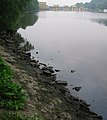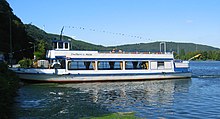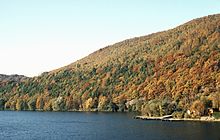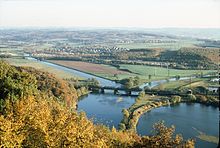Hengsteysee
| Hengsteysee | |||||||||||
|---|---|---|---|---|---|---|---|---|---|---|---|
| View from the Hohensyburg to the Hengsteysee | |||||||||||
|
|||||||||||
|
|
|||||||||||
| Coordinates | 51 ° 24 '50 " N , 7 ° 27' 43" E | ||||||||||
| Data on the structure | |||||||||||
| Construction time: | 1927-1929 | ||||||||||
| Data on the reservoir | |||||||||||
| Altitude (at congestion destination ) | 96 m above sea level NN | ||||||||||
| Water surface | 1.36 km² | ||||||||||
| Reservoir length | 4.2 km | ||||||||||
| Reservoir width | 296 m | ||||||||||
| Storage space | 3.3 million m³ | ||||||||||
| Particularities: |
The lake serves as a lower basin for a pumped storage power plant . |
||||||||||
The Hengsteysee is a 1929 of completed and from Ruhrverband operated reservoir during the Ruhr between the cities of Hagen , Dortmund and Herdecke in North Rhine-Westphalia , Germany . It is one of the six Ruhr reservoirs and named after the neighboring Hagen district of Hengstey .
The lake begins during the Ruhr approximately level with the Syburger Ruhrbrücke a kilometer below the Lenne -Mündung, its end forms the weir of the hydroelectric power plant Hengstey with a reservoir height of 4.6 m. North of the Hengsteysee, the Klusenberg rises as part of the Ardey Mountains . A large part of the lake belongs to the Hengsteysee / Ruhr landscape protection area, south bank .
The 4 km long lake has a storage volume of around 3.3 million m³.
Features of the lake
River treatment plant
The Hengsteysee was planned and created primarily as a "river sewage treatment plant" for the fine purification of the Ruhr water and the Lenne water flowing into it shortly before. The Lenne has been an industrial river with a lot of acid and iron since industrialization, and the Ruhr water was needed for the people of the Ruhr area (see also Ruhr Cleanliness Act of 1913). Biological self-cleaning and sedimentation processes are decisive for improving the water in the dysentery, which is only slowly flowing due to the damming . The reservoir becomes muddy and has to be dredged at intervals of several decades .
Although the water quality of the Lenne and Ruhr improved towards the end of the 20th century, the lake is still used for water purification.
Boulder catch
The Hengsteysee is also referred to as bed load trap. The Lenne carries a lot of river gravel ( rubble ) with it, which was transported on by the Ruhr before the reservoir was built, but is now deposited directly below the Lenne estuary and then in the Hengsteysee.
Hydropower
There are two hydropower plants at Hengsteysee , both of which are operated by RWE Energy .
On the north bank of the lake, the Koepchenwerk - a large pumped storage power plant in the Herdeck city area - uses the height difference of the Ruhr slope between an artificially created upper basin and the Hengsteysee, which serves as the lower basin, to store energy. The lake water is pumped up the mountain with electricity from other power plants during times of low electricity consumption (at night) and then drained again during peak load times during the day. Due to the daily pump storage operation, the water level of the Hengsteysee can fluctuate by almost one meter within a short time. This has significant consequences for marine ecology. The bank vegetation is correspondingly reduced, and many birds, usually breeding on the bank or in swimming nests, can do this only with great difficulty or with human help. In addition, smaller living beings (including fish) are caught in the suction of the pumps in spite of sieving devices and do not survive the power plant processes.
At the weir that closes the Hengsteysee, RWE operates the Hengstey run-of-river power plant , which was renovated in 2007 and a fish ladder was added in 2008 . The power plant generates a maximum output of 3,300 kilowatts. The actual weir, made up of four cylinder-shaped locks, can be opened at high water, and a lock system enables smaller ships to pass through.
The Koepchenwerk is located on the north bank of the lake.
The Hengstey run-of-river power plant forms the closure of the reservoir.
freetime and recreation
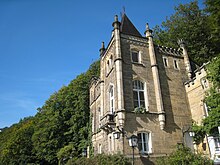
Today, the lake is particularly used for leisure purposes. There is a footpath and bike path around the lake (about 6.5 km), which is currently closed due to a landslide on the north side of the Niedernhof . The route on the south bank is part of the Ruhr Valley Cycle Route . Especially on weekends in summer, the lake is the destination of numerous day-trippers from the nearby cities of the Ruhr area.
In the warm season of the year, the “ Freiherr vom Stein ” tour boat sails between the “Am Schiffswinkel” landing stage in Herdecke and the Lenne estuary. At the northern end of the lake there is a boat rental ( pedal boats and rowing boats ).
In Dortmund's urban area directly above and at the beginning of the lake is the much-visited Hohensyburg (castle ruins, monument, vantage point, casino). The serpentines to Hohensyburg and the Syburger bridge over the Ruhr and the northern end of the Hengsteysee have been the scene and meeting point of motorsport since the 1920s. The car park at the southern end of the bridge with a snack bar called the “Bikertreff” is known as an excursion destination especially for motorcyclists.
The old Hagen open-air swimming pool Hengstey is on the south side of the lake .
The similarly large and comparably used Harkortsee begins within walking distance of a good 2.5 km downstream .
The Hengsteysee belongs to theme route 12 of the route of industrial culture - past and present of the Ruhr .
water sports
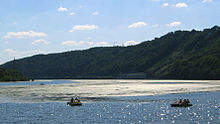
The Hengsteysee is a water sports area. There is sailing , rowing and canoeing on the lake . Several sports clubs are based on the lakeshore : Seglergemeinschaft Hengsteysee e. V. (SGHS), University Sailing Club Dortmund e. V. (USC), sailing group of the disabled sports community Hagen (BSG) with boathouse on Seestrasse, sailing club Syburg e. V. Dortmund, Canoe Club Hagen 1953 e. V. and Free Sports Club Dortmund 1898 (FS 98). The DLRG groups of the Dortmund district (water rescue station on Hengsteystraße) and OG Hagen (water rescue station on Seestraße) ensure safety on the water .
However, the Hengsteysee is unsuitable for swimming and bathing - it is not a bathing water , and the water quality of the Ruhr does not permit a corresponding permit. The health department also expressly warns against this, since several people had to seek medical treatment after contact with the lake water in September 2008.

Due to the sometimes shallow water depth (in some places less than 50 cm) and above all due to the summer mass increase of the waterweed (Elodea) since the late 1990s, water sports on the Hengsteysee are severely restricted.
Others
The construction work for the lake and the road bridge leading over the lake began in 1926. As early as 1927, the bridge collapsed, still under construction.
In the middle of the Hengsteysee, about 150 meters south of the power station, are the remains of the old Niedernhofen Castle owned by the Lords of Ovelacker .
On an island in the lake opposite the Seeschlösschen on the north bank, also known as the Funkenburg , there is the Mouse Tower , which was the bridgehead of a pedestrian suspension bridge over the Ruhr before the reservoir was built. The Seeschlösschen , called Villa Niedernhofen at the time of its construction , was built by the screw manufacturer Wilhelm Funke. The name Funkenburg is derived from this. In its time, the mouse tower was not only part of the bridgehead, but part of a building in which the staffed coachman of the Funke family lived and there were stables and carriage shed.
See also
Individual evidence
- ↑ The path at the Hengsteysee is closed. In: Westfalenpost. Funke Medien NRW, accessed on December 29, 2019 .
- ↑ http://www.personenschifffahrt-hengsteysee.de/
- ↑ Seglergemeinschaft Hengsteysee e. V.
- ↑ The West: Rash after a tour on Hengsteysee
- ↑ Shallow Lake Research in Germany: Mass Development of Aquatic Plants in the Ruhr Reservoirs ( Memento from January 2, 2010 in the Internet Archive )
- ↑ Note in: Richard Althaus : Hagen in old pictures . Vol. 2, Gummersbach 1978, p. 155.
- ↑ a b The sunken castle in the Hengsteysee. In: Active Seniors, Edition 51, Schwerte 2001, [1]
- ↑ http://www.hagen-eckesey.de/hengsteysee.htm
Web links
- Ruhrverband
- Description of all locations on this themed route as part of the Route of Industrial Culture



